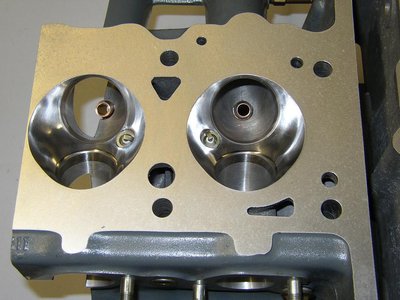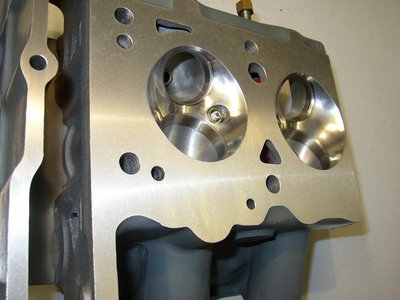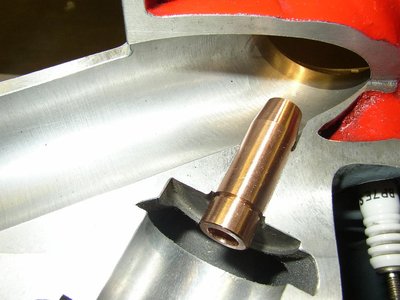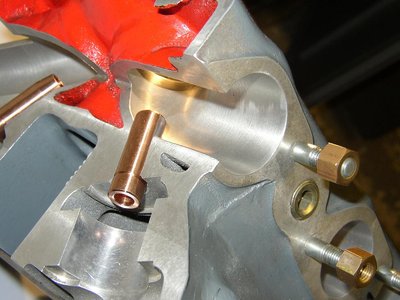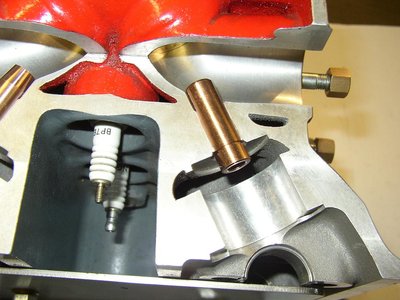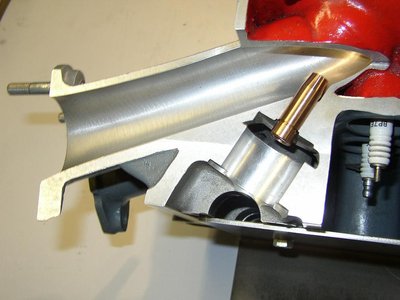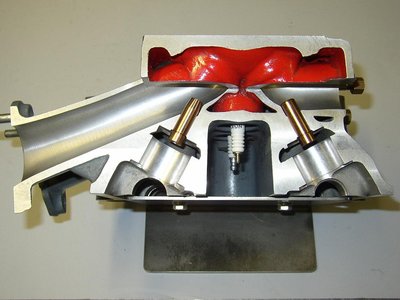Twin Cam Cylinder Head Porting
15 posts
• Page 1 of 1
A friend has been collecting casts of twin cam ports. Interesting to look at.
They are from one end to other
1. Standard unmolested twin cam
2. Hand ported twin cam done by local shop and flow bench
3. Hart 416B twin cam head - the original bench mark in twin cams - note how short the run is from the turn to the valve seat compared to the others - the whole head is much thinner than standard and the valves and combustion chamber are moved back into the head to enable the big 1.7 inch inlets and high cam overlap to work without the valves hitting. The porting also has broken through to the valve spring pocket bases and been sealed up with resin -apparently this was "normal" on the Hart heads.
4. McCoy racing porting from 3 years ago - his current version that is sitting on my bench now has flattened out the short radius turn into the valve a little to be more like the Hart head. Note how the porting is done to avoid the valve spring pocket
You can see why the McCoy heads are now the benchmark as they flow similarly to the Harts but without doing so much damage to the head.
cheers
Rohan
They are from one end to other
1. Standard unmolested twin cam
2. Hand ported twin cam done by local shop and flow bench
3. Hart 416B twin cam head - the original bench mark in twin cams - note how short the run is from the turn to the valve seat compared to the others - the whole head is much thinner than standard and the valves and combustion chamber are moved back into the head to enable the big 1.7 inch inlets and high cam overlap to work without the valves hitting. The porting also has broken through to the valve spring pocket bases and been sealed up with resin -apparently this was "normal" on the Hart heads.
4. McCoy racing porting from 3 years ago - his current version that is sitting on my bench now has flattened out the short radius turn into the valve a little to be more like the Hart head. Note how the porting is done to avoid the valve spring pocket
You can see why the McCoy heads are now the benchmark as they flow similarly to the Harts but without doing so much damage to the head.
cheers
Rohan
-

rgh0 - Coveted Fifth Gear

- Posts: 8831
- Joined: 22 Sep 2003
... Thanks Rohan for the lesson in images .
Its surprising how different the ports could be .
There is not so much space in the original head cast to play with , and these 4 casts show really that the hability and the knowledge can find its way ... but in an other hand , is spending time to reach the perfect shape worth !?!
I suppose that on full race engines with the "full monty" , it should be . But this engine has still to go in the right car , and be driven by the one who will be able to lap with constancy (with the same track condition, weather , tyres , aso) to found out the advantage of one to another ...
Btw: Yesterday , I put a new tacho(100mm Smiths 0/8000 ClassicMotorsport range) on "OEW" , and get ... a new engine!
By changing for an alternator the polarity change , and since then I was without any infos from the revs .
Now , I have an extra 1500rpm to play with!
Christian.
Its surprising how different the ports could be .
There is not so much space in the original head cast to play with , and these 4 casts show really that the hability and the knowledge can find its way ... but in an other hand , is spending time to reach the perfect shape worth !?!
I suppose that on full race engines with the "full monty" , it should be . But this engine has still to go in the right car , and be driven by the one who will be able to lap with constancy (with the same track condition, weather , tyres , aso) to found out the advantage of one to another ...
Btw: Yesterday , I put a new tacho(100mm Smiths 0/8000 ClassicMotorsport range) on "OEW" , and get ... a new engine!
By changing for an alternator the polarity change , and since then I was without any infos from the revs .
Now , I have an extra 1500rpm to play with!
Christian.

-

Old English White - Fourth Gear

- Posts: 754
- Joined: 12 Dec 2005
Rohan,
Very interesting casts. Sorry to add some road-road data to the racing section but I thought I would attach some recent flow bench results. I am gathering data in the early stages of building a 1700 long-stroke Twin Cam for my +2. In the attached plot you will see flow data for three cylinder heads. One is my converted (Stromberg-to-Weber) fresh from John McCoy with his CNC inlet porting. Another is the head I have been using for many years which was hand-ported by Ken Duclos. The third is a head ported by Curtis Boggs of Race Flow Development here in Virginia. All of these data were generated by Bill McCurdy of William's Racing in Harvard, Massachusetts on his flow bench. The Boggs head is the best road-going Twin Cam head that has ever been on Bill's flow bench. The McCoy head's inlet flow is close to that of the Boggs head at high valve lift. The Duclos head differs in that in was opened up for 45 DCOE Webers although he kept the cross sectional area small just above the valve head. John McCoy really opens up the inlet tract above the inlet valve head. We are trying to figure out why the McCoy exhaust port don't seem to flow as well as the others. All three heads have 1.56" diameter inlet valves and 1.31" diameter exhaust valves. At this time the plan is to build with the McCoy head. Thanks to RotoFlexible upon whose Twin Cam the Boggs head resides.
Very interesting casts. Sorry to add some road-road data to the racing section but I thought I would attach some recent flow bench results. I am gathering data in the early stages of building a 1700 long-stroke Twin Cam for my +2. In the attached plot you will see flow data for three cylinder heads. One is my converted (Stromberg-to-Weber) fresh from John McCoy with his CNC inlet porting. Another is the head I have been using for many years which was hand-ported by Ken Duclos. The third is a head ported by Curtis Boggs of Race Flow Development here in Virginia. All of these data were generated by Bill McCurdy of William's Racing in Harvard, Massachusetts on his flow bench. The Boggs head is the best road-going Twin Cam head that has ever been on Bill's flow bench. The McCoy head's inlet flow is close to that of the Boggs head at high valve lift. The Duclos head differs in that in was opened up for 45 DCOE Webers although he kept the cross sectional area small just above the valve head. John McCoy really opens up the inlet tract above the inlet valve head. We are trying to figure out why the McCoy exhaust port don't seem to flow as well as the others. All three heads have 1.56" diameter inlet valves and 1.31" diameter exhaust valves. At this time the plan is to build with the McCoy head. Thanks to RotoFlexible upon whose Twin Cam the Boggs head resides.
- Attachments
-
 Flow Bench Data.pdf
Flow Bench Data.pdf- (26.36 KiB) Downloaded 1120 times
Russ Newton
Elan +2S (1971)
Elite S2 (1962)
Elan +2S (1971)
Elite S2 (1962)
-

CBUEB1771 - Coveted Fifth Gear

- Posts: 1684
- Joined: 09 Nov 2006
Russ
My understanding is that McCoy deliberately constrains the exhaust side flow to around 80 % of the inlet as he believes based on his development work that this plus the short duration cams he uses provides the best combination of torque and power.
cheers
Rohan
My understanding is that McCoy deliberately constrains the exhaust side flow to around 80 % of the inlet as he believes based on his development work that this plus the short duration cams he uses provides the best combination of torque and power.
cheers
Rohan
-

rgh0 - Coveted Fifth Gear

- Posts: 8831
- Joined: 22 Sep 2003
rgh0 wrote:My understanding is that McCoy deliberately constrains the exhaust side flow to around 80 % of the inlet as he believes based on his development work that this plus the short duration cams he uses provides the best combination of torque and power.
Rohan,
Yes, that is John's approach and it is a widely accepted theory. Right now my exhaust is flowing at about 70% of the inlet except at the lowest valve openings. We'll get it sorted, it is always entertaining being the circus ring leader between two experienced engine developers (easily confused for aggravated Bengal tigers).
Russ Newton
Elan +2S (1971)
Elite S2 (1962)
Elan +2S (1971)
Elite S2 (1962)
-

CBUEB1771 - Coveted Fifth Gear

- Posts: 1684
- Joined: 09 Nov 2006
Interesting discussion on intake/exhaust sizing.
For a long time, a guide line has been to size the exhaust valve to produce nominal velocities (based on valve size) for the exhaust of 1.5 the intake. This is roughly 80% of the intake valve size.
This does not constrict the exhaust flow. Perhaps better is to look at the Mach value of the flow through the valves. For a modified TC head that gives nominal velocities based on valve head size of 240 fps and 350 fps, the nominal Mach values are around .215 and .147. The real exhaust Mach values are somewhat greater, but this gives you the idea.
Using a flow bench to validate porting modifications is better than nothing. Keep in mind that a flow bench uses a very small depression compared to the actual pressure differentials during most of the intake/exhaust strokes, and the real coefficients of discharge vary substantially when mapped against bar of pressure differential. Some shapes that measure well at low values of bar depression do not measure as well at higher values of bar depression. The problem is that a good part of the intake stroke happens at high depressions, but the critical period around BDC is at lower depressions.
Flow velocities in parts of the intake/exhaust tract will approach their limits (which should be Mach 1, but in practice is much less) for parts of the intake/exhaust cycle. It is the efficiency of conversion of this velocity energy to pressure energy after BDC that helps give us our high BMEPs.
David
1968 36/7988
For a long time, a guide line has been to size the exhaust valve to produce nominal velocities (based on valve size) for the exhaust of 1.5 the intake. This is roughly 80% of the intake valve size.
This does not constrict the exhaust flow. Perhaps better is to look at the Mach value of the flow through the valves. For a modified TC head that gives nominal velocities based on valve head size of 240 fps and 350 fps, the nominal Mach values are around .215 and .147. The real exhaust Mach values are somewhat greater, but this gives you the idea.
Using a flow bench to validate porting modifications is better than nothing. Keep in mind that a flow bench uses a very small depression compared to the actual pressure differentials during most of the intake/exhaust strokes, and the real coefficients of discharge vary substantially when mapped against bar of pressure differential. Some shapes that measure well at low values of bar depression do not measure as well at higher values of bar depression. The problem is that a good part of the intake stroke happens at high depressions, but the critical period around BDC is at lower depressions.
Flow velocities in parts of the intake/exhaust tract will approach their limits (which should be Mach 1, but in practice is much less) for parts of the intake/exhaust cycle. It is the efficiency of conversion of this velocity energy to pressure energy after BDC that helps give us our high BMEPs.
David
1968 36/7988
-

msd1107 - Fourth Gear

- Posts: 848
- Joined: 24 Sep 2003
[quote="CBUEB1771 We'll get it sorted, it is always entertaining being the circus ring leader between two experienced engine developers (easily confused for aggravated Bengal tigers).[/quote]
Yes engine development is fun and I think I race as it gives me an excuse to play with engines and helps me convince my wife why I have 7 cylinder heads and 13 blocks, a complete spare race engine, multiple cranks, cams etc currently in my workshop for future projects.
There is no "right answer" lots of ideas and rules of thumb but the real limits are the number of dollars you want to spend and the reliability constraints you set yourself.
My 5 rules I set myself are
1. Collect all the data you can and talk to as many poeple as you can. Believe real world experience and performance and discount those who talk but dont race.
2. A solid engineering approach to ensure repeatability in what you do is always a good starting point.
3. You should be able to at least directionally simulate on a good computer engine dyno simulation program any ideas you want to explore without spending big bucks excessively on alternate components and dyno time. This helps decide which of the begals tigers ideas to try for real.
4. If the engine ideas do not result in a reliable engine that will last me 3 years racing between rebuilds I cant afford to go down that path.
5. Every engine I build costs the same in jewelry and house rennovations as it does in engine bits so spend it wisely
cheers
Rohan
Yes engine development is fun and I think I race as it gives me an excuse to play with engines and helps me convince my wife why I have 7 cylinder heads and 13 blocks, a complete spare race engine, multiple cranks, cams etc currently in my workshop for future projects.
There is no "right answer" lots of ideas and rules of thumb but the real limits are the number of dollars you want to spend and the reliability constraints you set yourself.
My 5 rules I set myself are
1. Collect all the data you can and talk to as many poeple as you can. Believe real world experience and performance and discount those who talk but dont race.
2. A solid engineering approach to ensure repeatability in what you do is always a good starting point.
3. You should be able to at least directionally simulate on a good computer engine dyno simulation program any ideas you want to explore without spending big bucks excessively on alternate components and dyno time. This helps decide which of the begals tigers ideas to try for real.
4. If the engine ideas do not result in a reliable engine that will last me 3 years racing between rebuilds I cant afford to go down that path.
5. Every engine I build costs the same in jewelry and house rennovations as it does in engine bits so spend it wisely
cheers
Rohan
-

rgh0 - Coveted Fifth Gear

- Posts: 8831
- Joined: 22 Sep 2003
Rohan
Have you received or had a look at a new McCoy head lately to see how his ports are evolving?
Have you received or had a look at a new McCoy head lately to see how his ports are evolving?
Ford Escort Mk1 Lotus Twin Cam
Elfin Monocoque (Twin Cam)
Elfin Type 300 (Holbay S65 - 120E) mechanic
[email protected]
Elfin Monocoque (Twin Cam)
Elfin Type 300 (Holbay S65 - 120E) mechanic
[email protected]
-

SJ Lambert - Fourth Gear

- Posts: 738
- Joined: 19 Nov 2010
Yes just got the latest version of Johns race porting in a new converted head i had delivered a month ago. Have not much chance to look at it yet in detail but John says its another incremental improvement over the head shown in the port catss from now five years ago and the head i got a couple of years ago. My friend got similar a head at the same time a couple of months ago and I must chase him up to do a port cast to compare to the earlier heads casts.
cheers
Rohan
cheers
Rohan
-

rgh0 - Coveted Fifth Gear

- Posts: 8831
- Joined: 22 Sep 2003
I'm guessing that he is by now having to work hard to achieve those increments!! - I presume that the main area to look at is still the short radius to the valve - and with whatever else he's doing that's the bit that will be easily discoverable from casting the ports!
The bit I struggle to follow/understand the most is John's "rotating of valve timing events" - although if that is the same thing as as rotating the lobe centres on the cams (and I think it is) to promote volumetric effeciency - then I guess it is manipulating overlap, if that's the case, then there's a bit of light glimmering for me!!!
The bit I struggle to follow/understand the most is John's "rotating of valve timing events" - although if that is the same thing as as rotating the lobe centres on the cams (and I think it is) to promote volumetric effeciency - then I guess it is manipulating overlap, if that's the case, then there's a bit of light glimmering for me!!!
Ford Escort Mk1 Lotus Twin Cam
Elfin Monocoque (Twin Cam)
Elfin Type 300 (Holbay S65 - 120E) mechanic
[email protected]
Elfin Monocoque (Twin Cam)
Elfin Type 300 (Holbay S65 - 120E) mechanic
[email protected]
-

SJ Lambert - Fourth Gear

- Posts: 738
- Joined: 19 Nov 2010
rgh0 wrote:Hart 416B twin cam head - The porting also has broken through to the valve spring pocket bases and been sealed up with resin -apparently this was "normal" on the Hart heads.
I have a head that has exactly the same "breakthrough" into the ports due to deep spring platforms (and it also has signs of resin in there that appears to have been used to stop oil being sucked into the combustion chamber) - is there any way of identifying a Hart head?
I will have to have a look at the short turn ports on this head to see if there are any "telltale" signs of it possibly being a good quality head. The combustion chambers have definitely been messed with but i presumed it was down to welding work but maybe not?
-

promotor - Fourth Gear

- Posts: 765
- Joined: 16 Mar 2012
The general characteristics of a Hart head were as far as i know:
1. 1.7 and 1.4 inch valves. The valves are sunk into the head to avoid clash on overlap and the combustion chamber opened up around them.
2. Ports opened up very big so that they get very close or break through into the spring pockets. The spring pockets were not actually deepened much if at all.
3. The head reduced below standard thickness to get the compression ratio back up.
If you have a head with the break through into the spring pockets it may orginally have been a Hart head though hard to tell these days as lots of copies ( good and bad) were done by others. Spring pockets have often been deepened for fitting high lift cams so pocket break through on its own is not necessarily a sign that it was once a Hart head. The best and most meaningful sign is the port shape versus the casts I have shown above.
cheers
Rohan
regards
Rohan
1. 1.7 and 1.4 inch valves. The valves are sunk into the head to avoid clash on overlap and the combustion chamber opened up around them.
2. Ports opened up very big so that they get very close or break through into the spring pockets. The spring pockets were not actually deepened much if at all.
3. The head reduced below standard thickness to get the compression ratio back up.
If you have a head with the break through into the spring pockets it may orginally have been a Hart head though hard to tell these days as lots of copies ( good and bad) were done by others. Spring pockets have often been deepened for fitting high lift cams so pocket break through on its own is not necessarily a sign that it was once a Hart head. The best and most meaningful sign is the port shape versus the casts I have shown above.
cheers
Rohan
regards
Rohan
-

rgh0 - Coveted Fifth Gear

- Posts: 8831
- Joined: 22 Sep 2003
Hi All
I have recently picked up a cylinder head freshly modified by George Wadsworth of Racing Fabrications.
I will take a cast of the port and post a pic for comparison
Dave
I have recently picked up a cylinder head freshly modified by George Wadsworth of Racing Fabrications.
I will take a cast of the port and post a pic for comparison
Dave
Dave Hughes
S2 26R
Elan DHC Sprint
Shapecraft Honda powered S1(in progress)
Turbocharged 26R clone (also in progress)
Evora 400 development car ex Lotus Factory
S2 26R
Elan DHC Sprint
Shapecraft Honda powered S1(in progress)
Turbocharged 26R clone (also in progress)
Evora 400 development car ex Lotus Factory
-

bigvalvehead - Third Gear

- Posts: 441
- Joined: 11 Sep 2003
Hi All
I thought that the following pictures may be of further interest to those of you who have contributed and read Rohans posting on cylinder head modifying.
This large valve head (1.7" inch IN 1.4"inch Ex ) was one that I had modified some years ago. I had decided to use a new casting as none of the used heads that I had at the time were suitable for various reasons.
After hours of hand porting to suit the very large valves and the 48 Webers, fitting the oversize seats, lowering the chambers,fitting the bronze guides and all the final finishing etc etc, I stood back with a certain degree of satisfaction.
It was unfortunately rather short lived when I noticed a blemish in number three port. I gave it a prod with the end of a pencil only to find that it disappeared into the water jacket. A water jacket that should not have been there!! Fortunately the supplier of the head agreed.
It was used as a doorstop for a while until I got fed up with banging my shins on it. I then thought that I should at least make some use out of it, so decided to section it.
The way that I have sectioned it does not give a clear view of the full length of the ports, but at least it shows the internal structure which I hope will be of interest.
The inlet port has been machined to 1.400" at the point adjacent to the spring platform which is just about as big as I would like to go and yet there is still sufficient material remaining. I can't say the same about the proximity to the water jacket on number two as it can clearly be seen biased toward the inlet port. The cause of the problem.
Nick
I thought that the following pictures may be of further interest to those of you who have contributed and read Rohans posting on cylinder head modifying.
This large valve head (1.7" inch IN 1.4"inch Ex ) was one that I had modified some years ago. I had decided to use a new casting as none of the used heads that I had at the time were suitable for various reasons.
After hours of hand porting to suit the very large valves and the 48 Webers, fitting the oversize seats, lowering the chambers,fitting the bronze guides and all the final finishing etc etc, I stood back with a certain degree of satisfaction.
It was unfortunately rather short lived when I noticed a blemish in number three port. I gave it a prod with the end of a pencil only to find that it disappeared into the water jacket. A water jacket that should not have been there!! Fortunately the supplier of the head agreed.
It was used as a doorstop for a while until I got fed up with banging my shins on it. I then thought that I should at least make some use out of it, so decided to section it.
The way that I have sectioned it does not give a clear view of the full length of the ports, but at least it shows the internal structure which I hope will be of interest.
The inlet port has been machined to 1.400" at the point adjacent to the spring platform which is just about as big as I would like to go and yet there is still sufficient material remaining. I can't say the same about the proximity to the water jacket on number two as it can clearly be seen biased toward the inlet port. The cause of the problem.
Nick
Last edited by avro on Sun Dec 23, 2012 3:20 pm, edited 1 time in total.
- avro
- Second Gear

- Posts: 69
- Joined: 19 Aug 2011
Nice pics avro!
John McCoy has finished the stage 4 Weber conversion on my head and whilst awaiting it's arrival he's sent me the simulations for it which I showed to my machinist today. I was already a happy camper before shopping the figures around - the guys in Melbourne were most impressed as well!!!!
I think I've got a high torque and high power sim, the difference being a variation of lobe centres. It'll be interesting to see what the projections for a 1518cc engine build are.
I'll put my thinking cap on as far as manifold sizes are concerned whilst waiting as well!
John McCoy has finished the stage 4 Weber conversion on my head and whilst awaiting it's arrival he's sent me the simulations for it which I showed to my machinist today. I was already a happy camper before shopping the figures around - the guys in Melbourne were most impressed as well!!!!
I think I've got a high torque and high power sim, the difference being a variation of lobe centres. It'll be interesting to see what the projections for a 1518cc engine build are.
I'll put my thinking cap on as far as manifold sizes are concerned whilst waiting as well!
Ford Escort Mk1 Lotus Twin Cam
Elfin Monocoque (Twin Cam)
Elfin Type 300 (Holbay S65 - 120E) mechanic
[email protected]
Elfin Monocoque (Twin Cam)
Elfin Type 300 (Holbay S65 - 120E) mechanic
[email protected]
-

SJ Lambert - Fourth Gear

- Posts: 738
- Joined: 19 Nov 2010
15 posts
• Page 1 of 1
Total Online:
Users browsing this forum: No registered users and 8 guests

